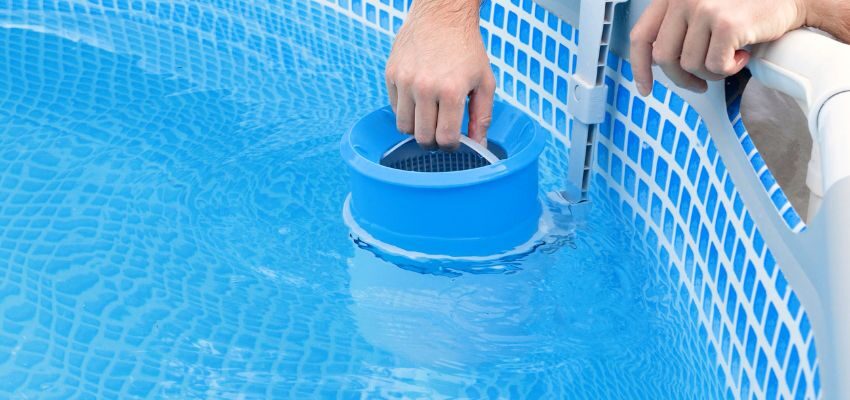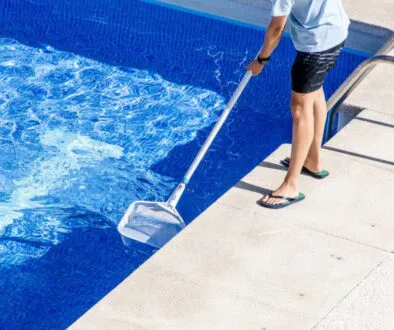How To Blow Out Pool Lines for Winter: A Step-by-Step Guide

Published April 17, 2023
It’s no secret that winter can bring a ton of problems to pool owners. For starters, if the pool isn’t drained of its water, it can very easily freeze in just a few days. Though the idea of frozen water isn’t so harmful that you’d want to spend hours preventing it, it’s much more detrimental than you think.
After all, if the water freezes, cracks can occur more easily, and if cracks do happen, certain parts of the pool may sustain long-term damage. Of course, you don’t want that to happen to your oasis.
That’s why it’s common practice to take steps to prepare the pool for winter. Among these, one step that’s overlooked by some pool owners is blowing out pool lines, which should be a crucial step.
What Does It Mean To Blow Out Pool Lines?
Blowing out pool lines means exactly what you’d expect. It’s the process of using a device that exhales air into the pool lines to “blow out” any residual water inside. For your reference, pool lines refer to the pipes buried underground in the pool system. They’re responsible for circulating water.
It’s a crucial winterization process since even with the pool drained of water, there’s likely going to be residual water inside the circulation system, a.k.a. the pipes. And that water can freeze very easily.
The idea behind this step is to ensure there’s no residual water inside the pipes since, if there is, it may freeze and cause cracks and other kinds of damage to the pipe. Overall, it’s similar to draining the pool, though this time, you’re draining the pool lines or pipes instead—it has the same merit.
How to Blow Out Pool Lines
The problem with this step is that it’s a bit trickier than simply draining the pool.
After all, if you’ve read our How to Close an Inground Pool for Winter, you’d know that this particular step is no different from the typical pool draining process where you unscrew the drain plug.
This time, you’re dealing with pipes that are usually not easily reachable. Fortunately, though, this process is not that much more difficult, as you can do so as long as you have guidelines to follow.
With that said, let this section be your guideline on how to blow out pool lines for the winter.

Let’s start by going over the equipment and other stuff you’ll need:
- Return fittings
- Skimmer plug
- Pool antifreeze
- An air compressor or a pool line blower
- Conical hose end connector (one you can connect to the air compressor or blower)
Once you have these ready, here’s what you need to do:
1. Remove Hardware From Your Return Fittings
Remove any hardware that’s installed on your return fittings. These are usually the ones that prevent water from coming out of these fittings easily. If you have multiple return fittings, remove them all.
Note: Return fittings are the holes that “returns” the filtered water back to the pool.
2. Blow Out From the Return Line
Connect the conical hose end connector to the blower or air compressor. Then, Insert the other end of that hose into the return line of your plumbing system. Next, you must turn on the air blower.
If there was residual water in the pipes, there should be water coming or blowing out of the return fittings. Only stop when there’s no longer water coming out, or you only see a barely visible mist of water emitting from the fittings. At that point, turn off the blower and plug back in the return fittings.
Note: The return line is part of the plumbing system where the filtered water comes in, and any water that passes through the return line is inevitably released to one of the pool’s return fittings.
3. Blow Out the Skimmer
Next, you need to blow out the skimmer but to do that; you must first open your skimmer and take out the skimmer basket. Then, like before, insert the hose into the skimmer’s plumbing line.
Turn on the blower, and like previously, water should start coming out of the skimmer. Again, only stop when there’s only a light mist of water coming out of it. At that point, insert the skimmer plug you bought. Keep in mind that they come in different heights, so choose one suitable for your skimmer.
Once that’s done, close the skimmer.
4. Blow Out From the Main Drain
For the fourth step, you must blow out from the main drain. To do so, insert the hose into the main drain’s plumbing line, then turn the blower on. Once that’s done, close the main drain off.
5. Pour Antifreeze Solution into the Main Drain
For the finishing touch, get your antifreeze and mix it into a bucket of water.
Once you have the diluted solution, pour it into the main drain.
That should prevent a phenomenon called ice expansion, where water expands when it freezes.
This is crucial since you won’t be able to remove the water from your pipes entirely, and even a little bit of it can expand enough when frozen and damage the pipe. It’s essentially a just-in-case solution.
Parting Words
Though we highly advise removing residual water from swimming pool lines for winter, you must keep in mind that this process is actually not exclusive to when winter is coming. You should do this if the outside temperature is getting excessively low. That’s why learning how to blow out pool lines is particularly crucial in regions where the temperature tends to be on the lower side.
Hire Boca’s Favorite Pool Builders
Excel Pool and Patio Solutions is your trustworthy provider of pool services in Boca Raton. We are experts in pool and patio remodeling and can handle your resurfacing needs as well. Our technicians are vetted and trained for your guaranteed satisfaction. Get to know us by browsing our website or reaching out to us with any questions.
Contact our team today to request a free estimate for pool construction, maintenance, repairs and more.

Fact Checked By Experts
This is original content and has been diligently fact checked by our internal team of experts. Discover more about the rigorous editorial standards we uphold for our website here.

About The Author
Lenard Arceo is an experienced writer and digital marketing expert. He loves to code and spending time outdoors. He has helped many reputable websites grow over the years.



